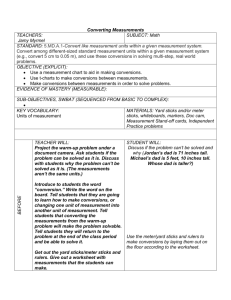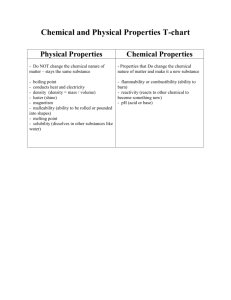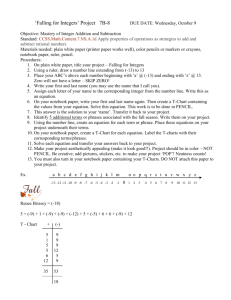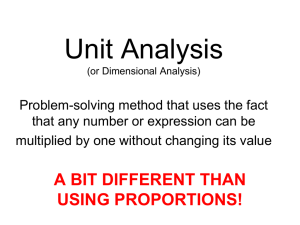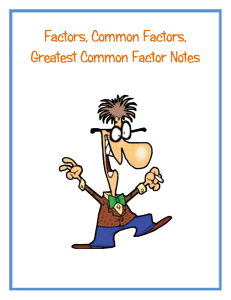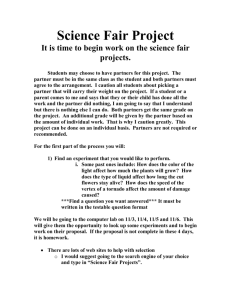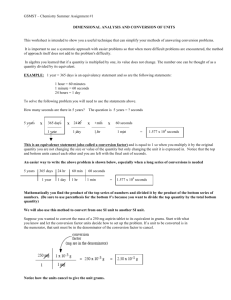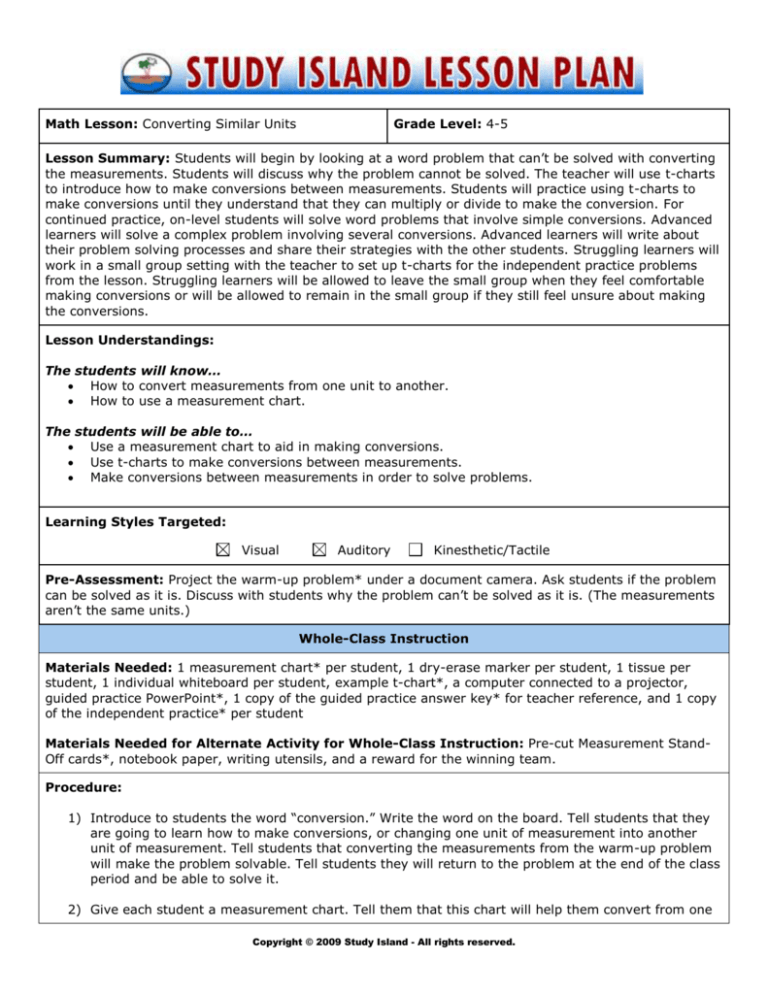
Math Lesson: Converting Similar Units
Grade Level: 4-5
Lesson Summary: Students will begin by looking at a word problem that can’t be solved with converting
the measurements. Students will discuss why the problem cannot be solved. The teacher will use t-charts
to introduce how to make conversions between measurements. Students will practice using t-charts to
make conversions until they understand that they can multiply or divide to make the conversion. For
continued practice, on-level students will solve word problems that involve simple conversions. Advanced
learners will solve a complex problem involving several conversions. Advanced learners will write about
their problem solving processes and share their strategies with the other students. Struggling learners will
work in a small group setting with the teacher to set up t-charts for the independent practice problems
from the lesson. Struggling learners will be allowed to leave the small group when they feel comfortable
making conversions or will be allowed to remain in the small group if they still feel unsure about making
the conversions.
Lesson Understandings:
The students will know…
How to convert measurements from one unit to another.
How to use a measurement chart.
The students will be able to…
Use a measurement chart to aid in making conversions.
Use t-charts to make conversions between measurements.
Make conversions between measurements in order to solve problems.
Learning Styles Targeted:
Visual
Auditory
Kinesthetic/Tactile
Pre-Assessment: Project the warm-up problem* under a document camera. Ask students if the problem
can be solved as it is. Discuss with students why the problem can’t be solved as it is. (The measurements
aren’t the same units.)
Whole-Class Instruction
Materials Needed: 1 measurement chart* per student, 1 dry-erase marker per student, 1 tissue per
student, 1 individual whiteboard per student, example t-chart*, a computer connected to a projector,
guided practice PowerPoint*, 1 copy of the guided practice answer key* for teacher reference, and 1 copy
of the independent practice* per student
Materials Needed for Alternate Activity for Whole-Class Instruction: Pre-cut Measurement StandOff cards*, notebook paper, writing utensils, and a reward for the winning team.
Procedure:
1) Introduce to students the word “conversion.” Write the word on the board. Tell students that they
are going to learn how to make conversions, or changing one unit of measurement into another
unit of measurement. Tell students that converting the measurements from the warm-up problem
will make the problem solvable. Tell students they will return to the problem at the end of the class
period and be able to solve it.
2) Give each student a measurement chart. Tell them that this chart will help them convert from one
Copyright © 2009 Study Island - All rights reserved.
unit of measurement to another. Give each student a whiteboard, a dry-erase marker, and a
tissue. Tell them that they are going to use a t-chart as a strategy to help them convert from one
measurement to another.
3) Pose the question, “How many quarts are in 6 gallons?” Draw a t-chart on the board. See example
t-chart, if necessary. Label the left side “gallons” and the right side “quarts.” Have students draw
the same t-chart on their whiteboards. Ask students to look at their measurement charts and find
the relationship between quarts and gallons. Choose a student to identify the relationship. Write 4
quarts equals 1 gallon on the t-chart. Ask students how many quarts would be in 2 gallons, and
write 2 gallons on the t-chart. Elicit responses. Record 8 quarts on the t-chart. Ask students how
they knew the answer was 8 quarts. Elicit responses. Students may say they added 4 quarts + 4
quarts. Lead students to see that they can multiply 2 gallons x 4 quarts. Now write 6 gallons on the
t-chart. Ask students how they can figure out how many quarts are equal to 6 gallons. Elicit
responses. Show the multiplication problem 6 x 4 on the t-chart.
4) Pose the question, “How many yards are equal to 27 feet?” Draw a new t-chart on the board. Label
the left side “yards” and the right side “feet.” Have students erase the t-chart from the previous
activity and copy the new t-chart on their whiteboards. Ask students to look at their measurement
charts and find the relationship between feet and yards. Choose a student to identify the
relationship. Write 1 yard equals 3 feet on the t-chart. Ask students how many yards are in 6 feet.
Record 6 feet on the t-chart. Elicit responses, asking the student to explain how s/he got 2 yards
as the answer. Lead students to see that they can divide the number of feet by 3 to find the
number of yards. Have students write 27 feet on the t-chart. Ask students to divide by 3 to find the
corresponding number of yards. Elicit answers from students. Record 9 yards on the t-chart.
5) Tell students that since they have learned how to use multiplication and division to convert, or
change, one unit of measurement into another, they will now use this skill to solve some word
problems on their whiteboards. Project the guided practice PowerPoint for students to see. Guide
students through each problem, making sure students understand how to use multiplication or
division to make the conversions. Refer to the guided practice answer key, if necessary. Emphasize
to students that sometimes an “extra” has to be added after making a conversion. For example,
when converting 5 feet, 2 inches into inches, you have to multiply 5 x 12 and then add on the 2
inches.
6) When you have finished guiding students through the PowerPoint, present the warm-up problem
again from the beginning of the lesson. Ask students what the two different measurements are:
inches and feet. Ask students what conversion needs to be made to make the problem solvable.
Elicit responses, and model solving the problem on the board. Students should also solve the
problem on their whiteboards. Students may say that 5 feet should be converted into inches by
multiplying 5 x 12, then 10 should be added to the product. After that, the two heights can be
compared because they are both measured in inches. Students may also say that 71 should be
divided by 12 to convert inches into feet. The remainder would represent how many inches there
are in addition to the number of feet. The two heights can then be compared because they are both
measured in feet and inches. Be sure that both possible solutions are presented, so students are
comfortable using both multiplication and division to convert.
7) After discussing the warm-up problem, give each student a copy of the independent practice. Allow
them to use their measurement charts as they work.
Procedure for Alternate Activity for Whole-Class Instruction:
1) This game can be used instead of the independent practice or as a test review. Prior to playing
Measurement Stand-off, copy the game cards and cut them apart. Place them in a stack face down
so that the questions are not visible.
2) Divide students into 4-5 teams. Give each student a copy of the measurement chart and a piece of
Copyright © 2009 Study Island - All rights reserved.
notebook paper to use as scratch paper. Tell students they will be playing a game called
Measurement Stand-Off. Explain the rules of the game to students. A representative from one
team will choose a question from a stack. The teacher will project the card under the document
camera for all students to see. The question will show two measurements. If the team is able to
correctly choose the larger measurement and explain how it found the correct answer, the team
will be rewarded points based on the difficulty of the question. If the team does not correctly
choose the larger measurement or is unable to explain how it found the answer, the team does not
receive any points. Play continues until there are no more cards.
3) When all cards have been played, the teacher will tell students it’s time for the Bonus Round. Each
team must agree on an amount of their points they want to wager. The team may not wager more
points than they have earned. Warn students that the Bonus Round question is very challenging.
Each team who gets the Bonus Round question correct will earn as many points as they wagered.
Each team who gets the Bonus Round Question incorrect will lose that many points. The team with
the highest amount of points after the Bonus Round will earn a reward.
Advanced Learner
Materials Needed: Writing utensils, 1 copy of the Advanced Learner problem* per student, and 1 copy of
the measurement chart* per student.
Procedure:
1) Gather advanced learners together. Have them bring their measurement charts or provide one to
each student.
2) Give each student a copy of the Advanced Learner problem. Read it out to students. Discuss the
different conversions they will have to think about when solving this problem. For example, point
out how the race is 1 yard long, but the racers are crawling distances measured in inches. Point out
how Tommy Turtle is timed in minutes, but Sammy Snail is timed in hours.
3) Once students have had time to think about the problem, allow them the choice to work
independently or in partners. After students have made their choice about how they’re going to
work, allow them to solve the problem. Remind students that they need to explain how they solved
the problem. You might want to give students the option to write an explanatory paragraph or to
write a step-by-step list detailing how they solved the problem.
4) When students have finished, have students share their solutions. Discuss with students the
different strategies they used to solve the problem.
Note: You may want to make a hallway or classroom display showcasing students’ critical thinking
and problem solving.
Struggling Learner
Materials Needed: 1 copy of the independent practice* per student, individual student whiteboards, 1
dry-erase marker per student, 1 tissue per student, writing utensils, and 1 measurement chart* per
student.
Procedure:
1) Have struggling learners bring their independent practice page and measurement chart to the small
group. In addition, give each student a whiteboard, a dry-erase marker, and a tissue.
2) Tell students that they are going to work on creating t-charts for some of the problems from the
independent practice. Have students look at the first problem. Ask students what two
Copyright © 2009 Study Island - All rights reserved.
measurements the first problem is asking about. Elicit responses. Model for students on the board
or on chart paper how to make a t-chart showing the relationship between feet and inches. Have
students create a t-chart on their whiteboards showing feet and inches. Have students find the
relationship between inches and feet on their measurement charts. Students should record 1 foot
equals 12 inches on their t-charts. Lead students through the t-chart to find that 6 feet equals 72
inches. Discuss using multiplication to find that conversion. Remind students that Abraham Lincoln
wasn’t exactly 6 feet tall. He was 6 feet, 4 inches tall. Discuss what to do with the extra 4 inches.
3) Continue helping students make t-charts for other problems from the independent practice. Allow
students to leave the small group when they feel comfortable making the conversions on their own.
Continue helping the ones who remain in the group set up t-charts to make the conversions.
*see supplemental resources
Copyright © 2009 Study Island - All rights reserved.

